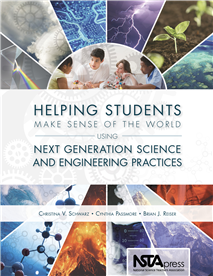All Book Chapters
Book Chapter
In this lesson, students will explore the relationship between earthquake depth and tectonic plate boundaries. Disciplinary core ideas covered are Earth materials and systems and plate tectonics and large-scale system interactions. Tips for scaling d...
Book Chapter
In this lesson, students will learn about the radiation levels in their state and county and compare them to levels in two other states. Teaching about radon addresses a safety issue and relates to content knowledge about radiation and geology. Disci...
Book Chapter
In this lesson, students will develop a model that illustrates that the tectonic plates are moving in different directions on Earth’s surface. Disciplinary core ideas covered are Earth materials and systems and plate tectonics and large-scale syste...
Book Chapter
In this lesson, students will explore volcanoes in the United States and relate them to tectonic plates in Earth’s crust. Disciplinary core ideas covered are Earth materials and systems and plate tectonics and large-scale system interactions. Tips ...
Book Chapter
In this lesson, students will use buoy data to determine the relationship between wind speed and wave height. Disciplinary core ideas covered are Earth materials and systems and the roles of water in Earth’s surface processes. Tips for scaling down...
Book Chapter
Dissolved Oxygen and Water Quality
In this lesson, students will explore the relationship between water temperature and dissolved oxygen. Disciplinary core ideas covered are natural resources and Earth’s systems. Tips for scaling down, scaling up, and extending the lesson are includ...
Book Chapter
In this lesson, students will explore how oceans mitigate climate at midlatitudes. Disciplinary core ideas covered are the roles of water in Earth’s surface processes and weather and climate. Tips for scaling down, scaling up, and extending the les...
Book Chapter
In this lesson, students will explore the relationship between the ocean tides and the cycles of the Moon. Disciplinary core ideas covered are the roles of water in Earth’s surface processes and Earth materials and systems. Tips for scaling down, s...
Book Chapter
In this lesson, students will see how photoperiods change during a year, at locations at different latitudes. Disciplinary core ideas covered are Earth and the solar system and Earth’s systems. Tips for scaling down, scaling up, and extending the l...
Book Chapter
In this lesson, students will illustrate and compare the patterns of day and night across the globe during different seasons. Disciplinary core ideas covered are Earth and the solar system and Earth’s systems. Tips for scaling down, scaling up, and...
Book Chapter
In this lesson, students will discover what planets they can locate in the evening sky and where to find them. Disciplinary core ideas covered are Earth’s place in the universe. Tips for scaling down, scaling up, and extending the lesson are includ...
Book Chapter
In this lesson, students will examine the biotic and abiotic features necessary for survival of an organism by developing a plan to go into hiding for a year in a remote location that would provide the conditions to support life. Disciplinary core id...
Book Chapter
When it’s time for a game change, you need a guide to the new rules. Helping Students Make Sense of the World Using Next Generation Science and Engineering Practices provides a play-by-play understanding of the practices strand of A Framework for K...
Book Chapter
This chapter addresses experimental and field observations, which include aspects of Asking Questions and Defining Problems; Planning and Carrying Out Investigations; Constructing Explanations and Designing Solutions; and Engaging in Argument From Ev...
Book Chapter
This chapter addresses experimental and field observations, which include aspects of Asking Questions and Defining Problems; Planning and Carrying Out Investigations; Constructing Explanations and Designing Solutions; and Engaging in Argument From Ev...




